Content
Sound Level
Decibels, dB
Noise Addition
Noise Level Subtraction
Noise Control Example
Sound Level
The range of sound pressure varies from 20x10-6 Pascals at the threshold of
hearing , up to 200 Pascals in the region of pain level or instantaneous damage.
The sound pressure is small when comparing with the normal atmospheric pressure
of 105.
The large orders of magnitude involved is inconvenient for quantitative
analysis. Besides, the perception of sound is also not directly proportional to
the sound pressure. A more meaningful scale is needed. The response of human ear
to the sound pressure is in logarithmic scale. And the threshold of
hearing, 20µPa at 1000Hz frequency is used as zero of the scale.
Decibels, dB
Decibel is a logarithmic scale used to measure the sound pressure level (SPL) in
practice. This is not an absolute scale, it is comparative scale with a
reference sound pressure of average threshold of hearing, 20µPa at 1000Hz.
The sound pressure level is defined as
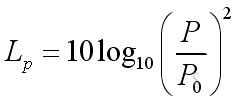
where
Lp is the sound pressure level
P is the sound pressure
Po is the reference pressure, 20µPa
Noise Addition
The global level of the total sound level is the algebraic sum of the acoustic energies,
Therefore for random sounds, as there is no interference, the superimposing of sounds at each point in space is only the summation of all energy sum. The resultant acoustic energy is the sum of individual acoustic source energies, not the sound levels of sources.
But for related sound sources, the resultant acoustic pressure field due to acoustic sources is the algebraic sum of the waveforms of each sources. The sum of acoustic pressure is time and space dependent. The resultant sound may have a larger amplitude with constructive interference or a smaller amplitude with destructive interference.
For uncorrelated or incoherent random noise, the acoustic pressures radiated from two sources A and B:
 and
and

where
LpA is sound level of source A
PA is sound pressure of source A
LpB is sound level of source B
PB is sound pressure of source B
Since the sound pressure ratio square in term of sound level is:
 .
.
The total sound level at a point in space by superimposing is:
 .
.
Or:
 .
.
For example:
Two sources 90dB and 90dB
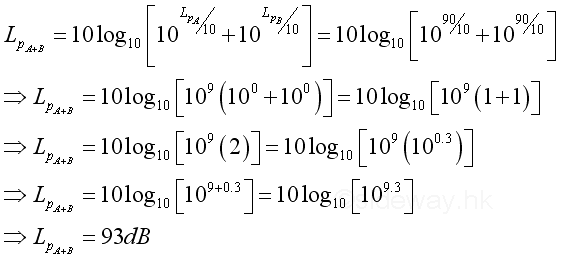 .
.
Multi sources 90dB, 100dB, 73dB and 93dB
 .
.
Noise Level Subtraction
When measuring the noise radiated by a noise source, the background noise from other sources is also included in the measurement reading by superimposing.
 .
.
In order to determine the actual noise level of a source, the background noise level should be measured before running the noise. Let A is the new noise source and B be the background noise. That is
 and
and

Therefore, the noise level of the new noise source:
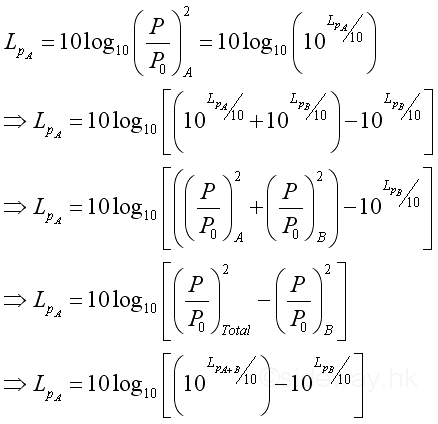 .
.
Or:
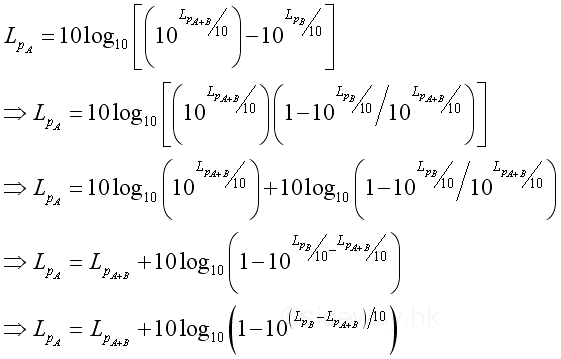 .
.
For example:
Measured total noise level 93dB and background noise 90dB
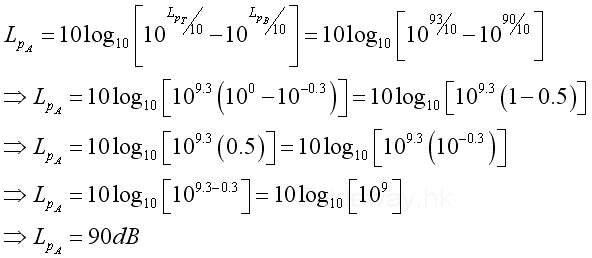 .
.
Measured total noise level 90.05dB and background noise 90dB
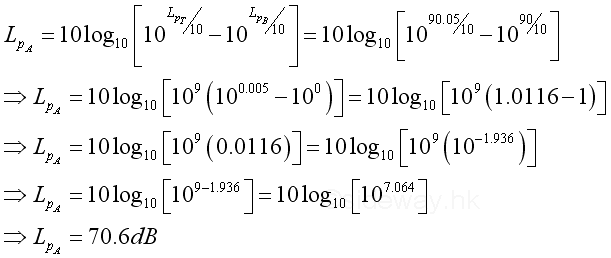 .
.
Noise Control Example
The noise level of 10 identical machines operating in a room is 54dB. In order to reduce the noise level to 50dB, the maximum number of machines can be used is?
Since ten identical machines run independently from each others, the noise from the ten identical machines can be considered as uncorrelated sound sources. The total noise level at a point in space generated by n identical machines can be determined by superimposing. imply
 .
.
Therefore the sound pressure generated by one machine is

The maximum number of machines can be used to generate the maximum sound level 50dB is
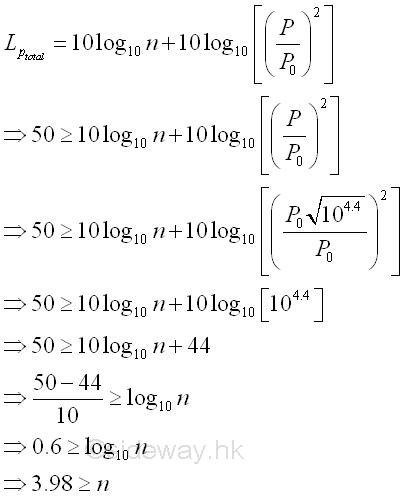
let n be 4, the total sound level is
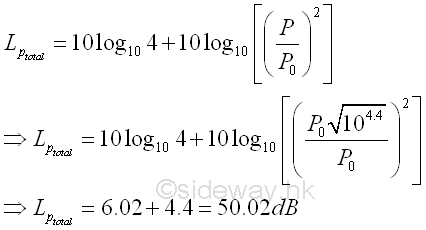
Since the total sound level only exceed 0.02dB, using maximum 4 machines are acceptable.
©sideway
ID: 100900008 Last Updated: 7/29/2012 Revision: 2 Ref:
References
- Michael P. Norton; Denis G. Karczub,, 2003, Fundamentals of Noise and Vibration Analysis for Engieer
- G. Porges, 1977, Applied Acoustics
- Conrad J. Hemond, 1983, Engineering Acoustics & Noise Control
- F. Fahy, 2001, Foundations of Engineering Acoustics
Latest Updated Links
- Ikea SANDSBERG table(last updated On 11/4/2025)
- Ikea TISKEN toilet roll holder(last updated On 11/3/2025)
- Philips CL400 Ceiling Light 36W(last updated On 11/2/2025)
- Philips CL400 Ceiling Light 24W(last updated On 11/1/2025)
- Philips CL400 Ceiling Light 13W(last updated On 10/30/2025)
- Ikea TISKEN basket(last updated On 10/29/2025)
- Ikea TISKEN towel rack(last updated On 10/28/2025)
- Ikea REXBEGONIA mattress protector(last updated On 10/27/2025)
- Ikea KEJSAROLVON mattress protector(last updated On 10/26/2025)
- Ikea KVARNVEN ergonomic pillow(last updated On 10/25/2025)
- Ikea BRUKSVARA pocket prung mattress(last updated On 10/24/2025)

 Nu Html Checker
Nu Html Checker  53
53  na
na  na
na
Home 5
Business
Management
HBR 3
Information
Recreation
Hobbies 8
Culture
Chinese 1097
English 339
Travel 18
Reference 79
Hardware 27![]()
Computer
Hardware 259
Software
Application 213
Digitization 37
Latex 52
Manim 205
KB 1
Numeric 19
Programming
Web 289
Unicode 504
HTML 66
CSS 65
SVG 46
ASP.NET 270
OS 431
DeskTop 7
Python 72
Knowledge
Mathematics
Formulas 8
Set 1
Logic 1
Algebra 84
Number Theory 206
Trigonometry 31
Geometry 34
Calculus 67
Engineering
Tables 8
Mechanical
Rigid Bodies
Statics 92
Dynamics 37
Fluid 5
Control
Acoustics 19
Natural Sciences
Matter 1
Electric 27
Biology 1
